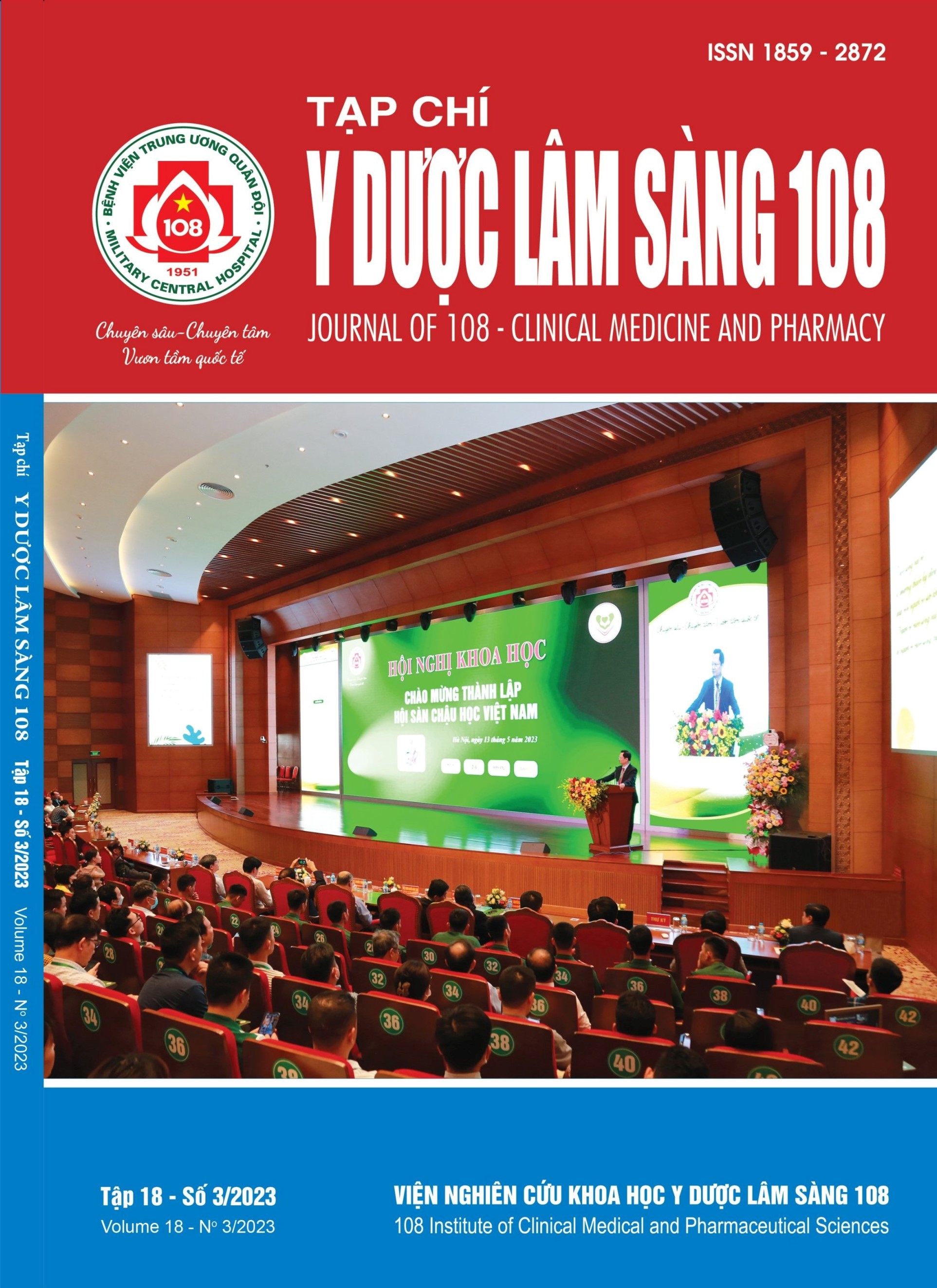Results of defects reconstructive surgery after tongue cancer resection at the 108 Military Central Hospital
Main Article Content
Keywords
Abstract
Objective: The study aimed to evaluate the effectiveness of the reconstruction of tongue defects after cancer resection. Subject and method: Retrospective combined prospective description were conducted on 36 patients with confirmed diagnosis of tongue cancer undergoing surgeries of defect resection and reconstruction by different methods at the Centre for Craniofacial and Plastic Surgery – 108 Military Central Hospital, from January 2019 to June 2022. Result: The patients aged between 24-84, average 57.06 years old, have a male/female ration of 3/1. Tongue cancer patients in stages I, II, III, IV were 8.33%; 52.78%, 8.33% and 30.56%, respectively. The simple tongue defect accounted for 30.56%, the remaining was the complex defect of the floor of the mouth, the tonsil column, and the mandible bone. Reconstructive methods of tongue defect after cancer removal included direct suture (30.56%), reconstruction by submental flap (25%), reconstruction by free flap (44.4%). The survival rate of plastic flaps was 100%. There were 5 patients with early complications accounting for 13.8%. Examination after 12 months, normal tongue moving function accounted for 33.3%; normal speaking function accounted for 13.8%, normal swallowing function accounted only for 2.8%. Conclusion: Defects after tongue cancer resection has many different degrees. Depending on the size and composition of the defect, reconstruction methods are appointed suitably. The outcome of rehabilitation depends mainly on the size of the defect in the tongue.
Article Details
References
2. Trần Đức Lợi (2003) Nghiên cứu đặc điểm lâm sàng và các yếu tốt tiên lượng ung thư lưỡi. Tạp chí Y học TPHCM, tr. 200-205.
3. Nguyễn Hữu Phúc (2004) Ung thư lưỡi: dịch tễ, chẩn đoán, điều trị. Luận văn tốt nghiệp Bác sĩ Nội trú, Đại học Y Dược TP. Hồ Chí Minh, TP. Hồ Chí Minh.
4. Trần Thanh Phương (2012) Nghiên cứu phẫu thuật và tạo hình trong điều trị ung thư lưỡi. Luận án Tiến sĩ Y học, Đại Học Y Dược TP. Hồ Chí Minh, TP. Hồ Chí Minh.
5. Lê Văn Quảng và cộng sự (2021) Đánh giá kết quả tạo hình khuyết hổng khoang miệng bằng vạt dưới cằm trong điều trị phẫu thuật ung thư khoang miệng. Tạp chí Y Học Việt Nam, tập 498, tr. 173- 177.
6. Bray F, Ferlay J, Soerjomataram I et al (2018) Global cancer statistics 2018: GLOBOCAN estimates of incidence and mortality worldwide for 36 cancers in 185 countries. CA Cancer J Clin 68(6): 394-424.
7. Zanoni DK, Montero PH, Migliacci JC et al (2019) Survival outcomes after treatment of cancer of the oral cavity (1985-2015). Oral Oncol 90: 115-121.
8. Schantz SP, Harrison LB, Forastiere AA (1997) Tumor of NASAL cavity and paranasal sinuses, nasopharynx, oral cavity & oropharynx. Cancer Principles and Practice of Oncology 5th ed: 915-919.
9. Song Xiao-meng, Ye Jin-hai, Yuan Ye et al (2010) Radial forearm free flap for reconstruction of a large defect after radical ablation of carcinoma of the tongue and floor of the mouth: Some new modifications. ORL J Otorhinolaryngol Relat Spec 72(2): 106-112.
10. Hicks LW, North HJ et al (1998) Surgery as a single modality therapy for squamous cell carcinoma of the oral tongue. Am. J. Otolarygol: 24-28.
11. Mosier K, Liu W-C, Behin B, Lee C, Baredes S (2005) Cortical Adaptation following Partial Glossectomy with Primary Closure: Implications for Reconstruction of the Oral Tongue. Annal Oto Rhinol Laryngol 114: 681-687.
12. Skoner JM, Hornig J, Day TA (2006) Reconstruction of partial glossectomy defects. Oral Cavity Reconstruction, pp. 205-219.
13. Martin D, Pascal JF, Baudet J et al (1993) The submental island flap: A new donor site. Anatomy and clinical applications as a free or pedided flap. Plast Reconstr Surg 92(5): 867-873.
14. Chuanjun C, Zhiyuan Z et al (2002) Speech after partial glossectomy: A comparison between reconstruction and nonreconstruction Patients. J Oral Maxillofac Surg 60: 404-407.
 ISSN: 1859 - 2872
ISSN: 1859 - 2872
